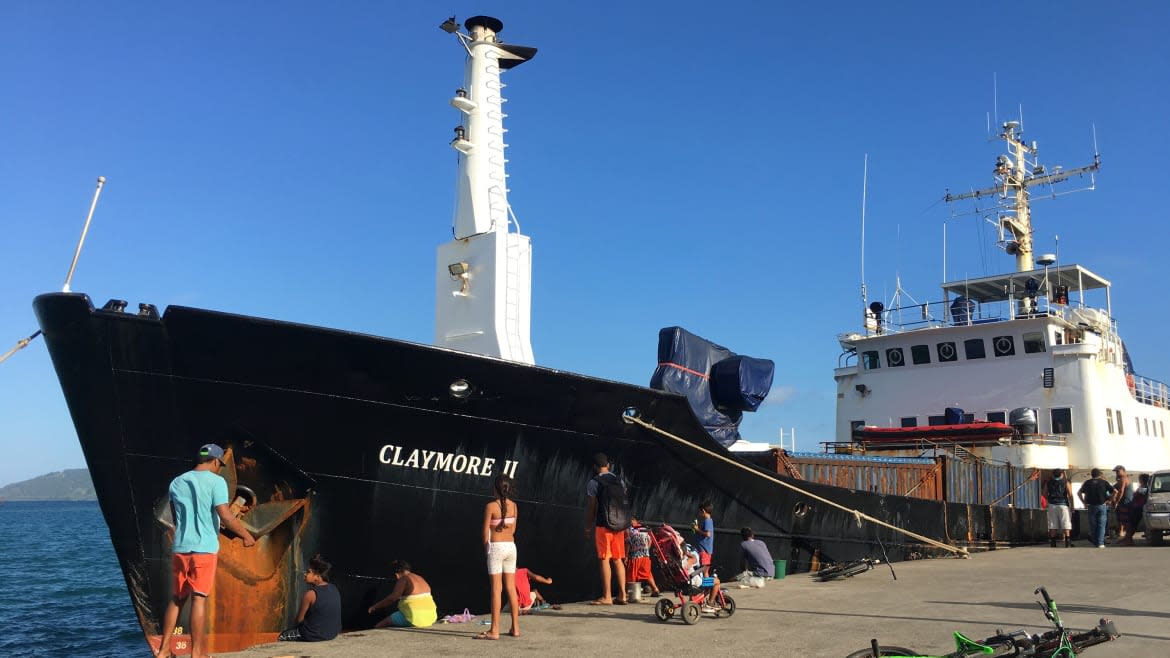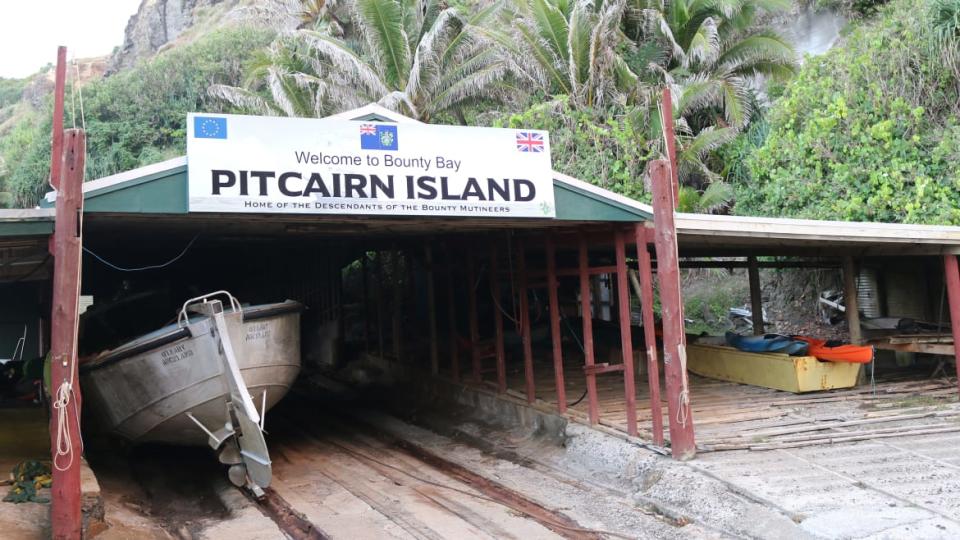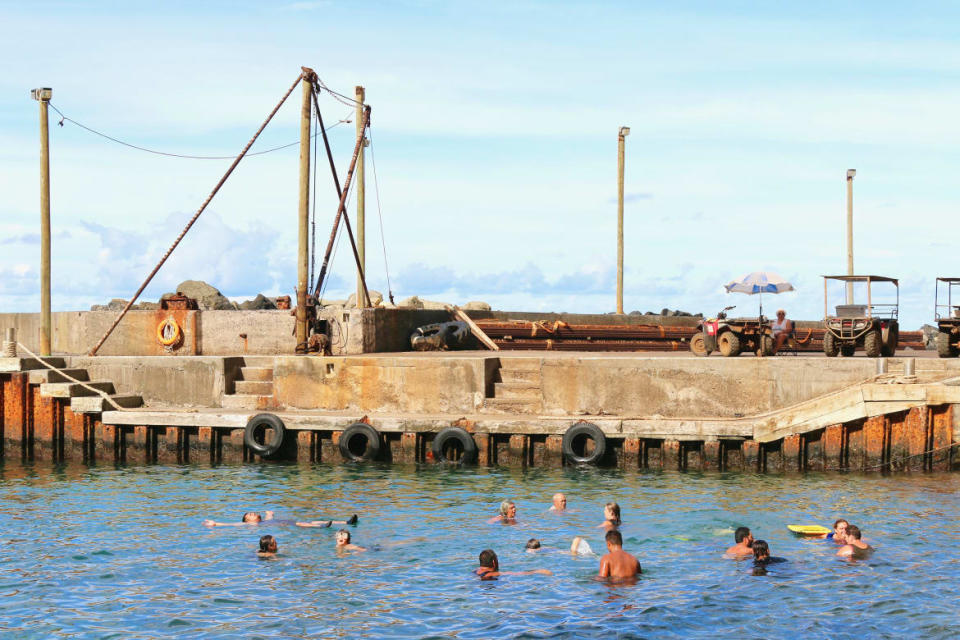Reaching the Farthest Corner of the World Is One Rough Trip

There are no stories of pirates in the South Pacific. While the Caribbean contains thousands of islets where marauding ships could find a sandy beach to stash their stolen treasure, the South Pacific is mostly water—punishing amounts of navy blue water. A desert of ocean, really.
Here, passing vessels never fell prey to peg-legged rumrunners. Instead, tales of moral depravity are relegated to the specks of land themselves, so impossibly far from one another—and away from watchful eyes—that only they bear witness to the bleakest forms of moral turpitude. This is where darker thoughts have their lease, where the scarcity of resources allows the rational mind to act with reckless desperation.
Early European explorers filled their journals with the grim details of cannibalism and human sacrifice, but the region’s modern-day history is just as rife with disturbing accounts of torture, incest, and vanishing tourists. The deeper one travels toward the brink of civilization, the more improbable the stories become. In the 1980s, an actual witch hunt took place on the distant isle of Faaite, wherein a mob of religious zealots slaughtered six of their neighbors, whom they believed to be possessed by demons. Until as recently as the ’90s, the atoll of Mururoa, more distant still, was used as a live nuclear testing site by the French government, which dropped almost 200 bombs—some 100 times stronger than the atomic weapons that flattened Hiroshima and Nagasaki—then tried to cover up the side effects: rampantly rising rates of cancer and deformities in eastern Polynesia.
Why Barack Obama Chose Marlon Brando’s Island Hideaway
In the shadow of Mururoa’s mushroom cloud—its fallout zone—lies the final passage to Pitcairn.
Pitcairn was a name I couldn’t un-hear after well over 100 countries visited and millions of words written about emerging destinations for various guidebooks and magazines. My geographical interests had veered sharply toward the obscure, and the story of Pitcairn’s founding—a series of events sparked by His Majesty’s Armed Vessel Bounty’s legendary mutiny in April 1789—was so disturbing and surreal that it ran like ticker tape in the back of my mind: Faced with their imminent return to England after six blissful months in Tahiti, the Bounty’s notorious crew, led by Fletcher Christian, cast their commanding officer William Bligh adrift in a dinghy then disappeared into the night in search of a place to hide—the uninhabited island of Pitcairn.
Clark Gable, Marlon Brando, and Mel Gibson all played Fletcher Christian in three separate major motion pictures. In Gibson’s 1984 version—a slightly more faithful representation of the true events that went down—there’s a block of text that appears on the screen at the end of the movie before the credits roll: “The mutineers’ fate remained a mystery for 18 years until their island was discovered by an American whaling ship… What happened to Fletcher Christian remains uncertain… However, his descendants live on Pitcairn Island to this day.”
There were still castaways living on this godforsaken rock over 200 years later. This was the first thing I knew about Pitcairn. Incredibly, this community—no greater than 50 people—had been largely subsisting on the profits of postage sales for several decades, hawking reams of their obscure stamps to eager collectors who gladly paid a premium for the novelty of having little bits of paper sporting breadfruit and Bounty drawings from the far side of the world. But with philatelic interest on the decline, the island—a tax-exempt adjunct of the United Kingdom—was now eyeing tourism as a possible new revenue stream.
The second thing I knew about Pitcairn was that it was far. So far, in fact, that at one time it was considered the most remotely inhabited place on the entire planet—a superlative that both intrigued intrepid travelers and filled them with pangs of frustration, as not a single form of commercial transportation links the island to the rest of the world. There were no hotels or restaurants as well.

Only a freighter sustained the islanders on a supply run undertaken once every three months, and a berth had been made available on board so that a single journalist—Pitcairn’s first visitor welcomed under this new tourism initiative—could spend a couple of weeks on the island, living at a local’s home, while the vessel shuttled a few passengers to French Polynesia for medical care before definitively departing until its next seasonal run.
In total, the trip into the unknown would take a full month, from New York City to Los Angeles, then on to Tahiti to wait for a puddle-jumper to fly me a thousand more miles to a distant atoll deep in the South Pacific, where the cargo ship would pick me up and ferry me across a final 300 miles of cruel and unpredictable ocean. The journey, famously described by a National Geographic explorer, takes longer than getting to the moon. But I couldn’t resist—I needed to know what happened when you fell off the map.
A white van picked me up before 4 a.m. and shuttled me to Tahiti’s international airport, where I waited for my flight to the other side of French Polynesia, 1,000 miles away. Mangareva was my destination, the largest island in the Gambier archipelago—scattered remnants of an ancient volcanic blast that carve the southeasterly boundary of the region. Like Pitcairn, Mangareva was far too craggy and rugged for a runway, but a raised coral shoal nearby provided the perfect stretch of flat terrain for a landing strip.
The journey on the Air Tahiti propeller plane took four hours, including a stop halfway on a sparsely inhabited atoll where the majority of the passengers disembarked.
After landing on the thin motu islet of crushed shells, I was escorted to a small ferry that connected the airport (read: tarmac and shack) to the village of Rikitea, where most of Mangareva’s 1,000 or so inhabitants lived.
The metal spars of the Motor Vessel Claymore II dwarfed the other structures along the bay; Pitcairn’s cargo freighter was tethered sideways against the dock as it made its final preparations before departure. Built in West Germany during the 1960s, the ship was 160 feet long (almost twice the size of the Bounty) and lacquered in thick coats of glossy black paint in an attempt to cover up some of the rusting.
Four times a year, the Claymore left the port of Tauranga, New Zealand, shuttling supplies to Pitcairn on its slow crawl across the South Pacific. A detour in the Gambiers allowed Pitcairners and their visitors to reduce the length of their transit time by embarking and disembarking in Mangareva and completing the rest of the journey by airplane. Still, however, two nights had to be spent aboard the Claymore for the last 300 miles of open water. There was no other way to reach Pitcairn.

The freighter wasn’t scheduled to depart until the very end of the day, which gave me plenty of time to explore my surroundings.
Long before radiogenic clouds rained poison over its inhabitants, Mangareva was an unlikely stronghold for the Catholic mission, when European priests in heavy robes sailed from island to island smashing ceremonial marae and adulterating the Polynesian way of life. Evangelized islanders were put to work, chiseling blocks of granite and coral to build a convent and a cathedral, which, to this day, are set in stark contrast to the airy thatched huts that surround it. The lavishness of the Christian complex starkly contrasts with the surrounding poverty as well.
The twin steeples of Saint Michael’s Cathedral—the biggest church in all of French Polynesia—rose twice as high as the masts of the Claymore. Down the hill, children were kicking soccer balls on a dusty field while their fathers unloaded fish from the backs of their pickup trucks nearby.
Out of town, a ribbon of pavement wound its way up the side of the island’s volcanic ridges. I followed the path through a series of hairpin turns until I came down the other side, and there, at long last—far from the rumbling storms that had seemed to permanently enshroud Tahiti—“I could get used to this,” I thought, and began to entertain the fantasy of one day retiring and sailing around the world.
At 5 p.m. we were asked to muster aboard the Claymore at the picnic tables in the dining mess both to receive a safety briefing and to skip our clocks forward an hour to sync up with Pitcairn (which, in a strange deception of geography, shares the same time zone as the West Coast of the United States). Then the ship’s cook—a middle-aged woman more weatherworn than her fellow crewmen—ushered out a long, cafeteria-style tray of our evening meal. It had the look of a microwave lasagna but was made with beans and Mexican spices. “Fusion!” she announced, beaming with unfounded pride.
According to maritime law, the Claymore could carry a maximum of 12 passengers on board without being classified as a passenger ship. We were nine. There were six Pitcairners: grandparents with their teenage grandson, and a mother and father with their young daughter in braids. And there were two other visitors besides myself: a retired astronomy professor from New Zealand taking starlight measurements from the island and a wealthy German tourist who was a self-avowed Mutiny on the Bounty superfan. He had even made special business cards for the occasion engraved with his name, a small motif of a ship’s steering wheel, and “HMAV Bounty Enthusiast” neatly typed underneath, which he eagerly handed out.
A professor, a millionaire, and a girl in pigtails; the allusion to Gilligan’s Island wasn’t lost on me. I, however, was going to purposefully maroon myself on Pitcairn after the Claymore departed.
Initially, I had thought the journey on the freighter was going to be a convenient opportunity to start getting to know the various Pitcairners aboard, but everyone scurried below deck and locked themselves away in their berths as soon as they finished dinner. One crewman noticed me lingering and suggested I make use of the showers before we left the dock. “Once we’re at sea, you won’t be doing much moving around.” Even the calmest of weather forecast during the ship’s passage still promised the inevitability of thrashing seas.

The first level below the main deck was reserved for the Claymore’s crew. Each of the eight members had their own little cabin with scuffed plexiglass portholes. The rest of us were relegated to the windowless hold one more level down, a shrewd reminder that this was not in fact a tourist transport and that, in a way, its nine passengers were cargo too. There was a benefit to being all the way down below, however; the closer one was to the ocean’s surface, the less susceptible one was to its rollicking waves.
Each cabin had three beds—two small, stacked berths and a larger double mattress separated by a tiny pedestal sink that came with explicit orders from the captain: “If you’re going to be sick, please do it in a bucket instead.” The professor and I had been assigned to the same room. I offered him the comfort of the double bed, which he took without hesitation, and I organized my belongings on the bottom bunk, certain that I would fall from the top when we encountered rougher water.
After my shower I explored the rest of the ship. Besides the dining mess, there was only one other common area—a small lounge with a plush sofa pointed at an outdated television and DVD player. Every other area of the Claymore had been overtaken by stacks of imported goods. Whatever hadn’t fit in the iron shipping containers on the foredeck was crammed into the various nooks and crevices on board. Even the lounge had crates of Spam and pallets of eggs stacked high next to the TV.
At sunset we began to glide through Mangareva’s sapphire lagoon. I stepped out on the stern to find the ship’s cook chain-smoking a pack of cigarettes. We watched as the volcanic towers of the Gambiers slowly drifted back into the horizon.
“Rippa view,” she rasped with her Kiwi twang before puffing another drag.
“I could get used to this,” I thought, and began to entertain the fantasy of one day retiring and sailing around the world.
I wandered back upstairs to the lounge for a final glance at the fading archipelago out the window. The ship then began to violently pitch and yaw before emitting a loud, bellowing creak from the deepest bowels of the hull. We had ventured into open water. I should have battened down the hatches like the others, but instead I languished on the sofa, grabbing bolts of its itchy polyester fabric by the fistful while I tried to hold on.

The onset of seasickness is like hearing a really terrible secret. It begins as a whisper—so faint, it’s almost a passing notion—but then it starts to get louder, slow at first, but soon it’s the only thing on your mind. And when you finally wish you had never heard this terrible secret in the first place, it’s already too late. The thought is all-encompassing now, and you have no choice but to blurt it out—only it’s not words that come up but vomit instead.
I was suddenly reacquainted with my taco-lasagna dinner. It didn’t look much different from the serving tray.
Pale and green, I sheepishly sought out the captain, who handed me a bucket even before I could muster up the energy to ask for one. I then climbed down to the lowest deck and curled myself up in my bunk. The professor was already asleep, presumably lulled into unconsciousness by the steady motoring of his own flatulence. I was too weak to look for my headphones, so I cupped my hands over my ears until I fell asleep—my dream of one day sailing around the world had become a delusion.
In the late morning on our second day at sea, I managed to extricate myself from the recycled air downstairs and took the captain up on his open invitation to visit the bridge. Out the windows, for as far as we could see, there were only waves and clouds in every direction—swollen mounds of crestless ocean and caravans of cumuli and nimbi unbroken by landfall. On the nautical charts, our journey seemed short relative to the surrounding vastness of the page. I mouthed the names of the other dots on the map—sacred oases across the void—but we would pass none of them, even within distant eyeshot, on the final push to Pitcairn.
From the captain’s chair, I watched how a shoreless sea could roll even a hulking freighter on a relatively calm day. The Claymore’s front mast ticktocked like a metronome, as though it were eagerly trying to sip the Pacific as it swung from side to side.
Worried our dinner would be another calamity of mismatched ingredients excused as fusion cuisine, I snuck back down to the hold, tucked myself into my berth, and cracked open my emergency stash of granola bars before closing my eyes to better relieve myself of the interminable nausea.
At around 4 a.m. I awoke to the most grating sound of scraping metal, a shrill squeaking that reverberated across the vessel like a dentist’s drill. The freighter was unspooling its anchor—it dropped hundreds upon hundreds of feet to the bottom of the ocean despite our proximity to land. I immediately crawled out of my bunk, climbed the ladders up to the main deck, and peered overboard to find the high beams of several blue-green floodlights shining out from the ship’s hull just below the waves. They had attracted hundreds of writhing reef sharks that were basking in the glow as they hunted for tropical fish.
In the quiet of the moonless night, I couldn’t see the island, but I knew Pitcairn was there.
Adapted from The Far Land: 200 Years of Murder, Mania, and Mutiny in the South Pacific by Brandon Presser, copyright © 2022. Reprinted by permission of PublicAffairs, an imprint of Hachette Book Group, Inc.
Get the Daily Beast's biggest scoops and scandals delivered right to your inbox. Sign up now.
Stay informed and gain unlimited access to the Daily Beast's unmatched reporting. Subscribe now.

